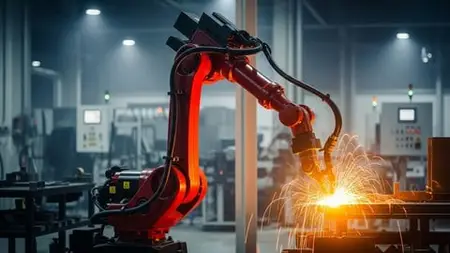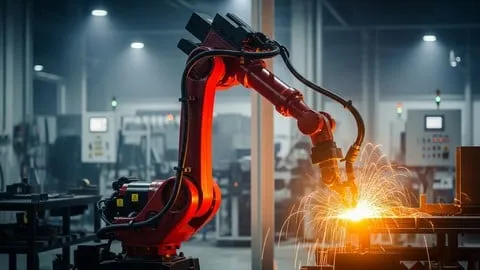Python-Powered Manipulator Robotics
Published 8/2025
MP4 | Video: h264, 1920x1080 | Audio: AAC, 44.1 KHz
Language: English | Size: 2.27 GB | Duration: 7h 58m
Published 8/2025
MP4 | Video: h264, 1920x1080 | Audio: AAC, 44.1 KHz
Language: English | Size: 2.27 GB | Duration: 7h 58m
"Kinematics, Modeling, Simulation, Trajectory Planning, and Workspace Analysis of Robotic Manipulators Using Python"
What you'll learn
Analyze and simulate the workspace and motion of standard manipulators in Cartesian, Cylindrical, and Polar coordinate systems using Python.
Apply rotation matrices and Euler angles to model and simulate 3D motion of rigid bodies and coordinate transformations in space.
Derive and implement forward kinematics and Jacobian matrices using DH parameters to evaluate workspace, motion, and singularities.
Generate smooth joint space trajectories and solve inverse kinematics algebraically for manipulators using Python simulations.
Requirements
This course is beginner-friendly with no strict prerequisites! A basic understanding of Python programming and high school-level math (especially vectors and matrices) will be helpful. Learners only need a computer with internet access — all coding can be done using Google Colab, so there's no need to install software. Most importantly, bring a curiosity to explore robotics and a willingness to learn by coding — I’ll guide you step-by-step!
Description
This hands-on course offers an engaging introduction to the world of robotic manipulators using Python. Designed for engineering students, robotics enthusiasts, and beginner coders, it provides a step-by-step guide through essential topics in robot motion and control.Starting with the basics, you'll explore rigid body motion, coordinate transformations, and Euler angles. The course then delves into robot kinematics, where you’ll learn how to model robotic arms using Denavit–Hartenberg (DH) parameters and simulate their behavior through code. Interactive Python exercises help you compute forward kinematics, analyze the robot's reachable workspace, and detect singularities using the Jacobian matrix.Beyond static analysis, the course introduces trajectory planning techniques to generate smooth, realistic motion for robot joints and end-effectors. You’ll also explore practical scenarios and learn how to implement path planning effectively. All implementations are carried out using Python in Google Colab, making it easy to learn without needing any software installations or hardware setup.By the end of the course, you'll not only understand how robotic arms move and interact with their environment but also gain the practical coding skills to simulate, analyze, and control them. Whether you're preparing for robotics research, automation projects, or just exploring the field, this course will provide a strong foundation using accessible, hands-on programming with real-world relevance.
Overview
Section 1: Introduction
Lecture 1 Introduction
Lecture 2 Workspace Analysis of standard Manipulators
Lecture 3 Workspace Analysis of standard Manipulators - Python simulation
Section 2: Homogenous Transformations
Lecture 4 Homogenous Transformations - Theory
Lecture 5 Homogenous Transformations - Numericals with Python
Lecture 6 Homogenous Transformations for Standard Manipulators - Theory
Lecture 7 Homogenous Transformations for Standard Manipulators - Python Simulation
Lecture 8 Euler Angles and Gimbal Lock
Lecture 9 Euler Angles and Gimbal Lock animation using Python
Lecture 10 DH formulation using Forward Kinematics
Lecture 11 Forward Kinematics using DH formulation - Python simulation
Lecture 12 Workspace Calculations using Forward Kinemtics
Lecture 13 Workspace Calculations using Forward Kinemtics - Python simulation
Section 3: Jacobian and Singularity
Lecture 14 Jacobian and Singularity calculation
Lecture 15 Jacobian and Singularity calculation using Python
Section 4: Inverse Kinematics
Lecture 16 Inverse Kinematics
Lecture 17 Inverse Kinematics using Python
Section 5: Trajectory Planning
Lecture 18 Trajectory Generation I
Lecture 19 Trajectory Generation using Cubic polynomial - Python
Lecture 20 Trajectory Generation II - Linear function with parabolic blends
Lecture 21 Linear function with parabolic blends - Python
This course is ideal for engineering students, hobbyists, and early-career professionals who are curious about robotics and want to learn how robotic manipulators work through hands-on programming. Whether you're from mechanical, electrical, electronics, or computer science background, if you're interested in simulating robot motion, understanding kinematics, or planning robotic tasks using Python, this course is for you. It’s especially valuable for learners who enjoy problem-solving and want to build practical skills in robotics through coding — no prior experience in robotics is required!



